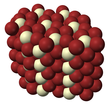Lanthanum(III) chloride
 Anhydrous
| |||
| |||
| Names | |||
|---|---|---|---|
| Other names
Lanthanum trichloride
| |||
| Identifiers | |||
| |||
3D model (
JSmol ) |
|||
| ChemSpider | |||
ECHA InfoCard
|
100.030.202 | ||
| EC Number |
| ||
PubChem CID
|
|||
| UNII |
| ||
CompTox Dashboard (EPA)
|
|||
| |||
| |||
| Properties | |||
| LaCl3 | |||
| Molar mass | 245.264 g/mol (anhydrous) 353.36 g/mol (hexahydrate) 371.37 g/mol (heptahydrate) | ||
| Appearance | white odorless powder hygroscopic
| ||
| Density | 3.84 g/cm3[1] | ||
| Melting point | 858 °C (1,576 °F; 1,131 K) (anhydrous)[1] | ||
| Boiling point | 1,000 °C (1,830 °F; 1,270 K) (anhydrous) | ||
| 957 g/L (25 °C)[1] | |||
| Solubility | soluble in ethanol (heptahydrate) | ||
| Structure[2] | |||
UCl3 type), hP8
| |||
| P63/m, No. 176 | |||
a = 0.74779 nm, b = 0.74779 nm, c = 0.43745 nm
| |||
Formula units (Z)
|
2 | ||
| Tricapped trigonal prismatic,(nine-coordinate) | |||
| Related compounds | |||
Other anions
|
Lanthanum oxide | ||
Other cations
|
Cerium(III) chloride | ||
Except where otherwise noted, data are given for materials in their standard state (at 25 °C [77 °F], 100 kPa).
| |||
Lanthanum chloride is the inorganic compound with the formula LaCl3. It is a common salt of lanthanum which is mainly used in research. It is a white solid that is highly soluble in water and alcohols.
Preparation
Anhydrous lanthanum(III) chloride can be produced by the
In the first step, lanthanum oxide is heated with ammonium chloride to produce the ammonium salt of the pentachloride:- La2O3 + 10 NH4Cl → 2 (NH4)2LaCl5 + 6 H2O + 6 NH3
In the second step, the ammonium chloride salt is converted to the trichlorides by heating in a vacuum at 350-400 °C:
- (NH4)2LaCl5 → LaCl3 + 2 HCl + 2 NH3
Uses
Lanthanum chloride is also used in biochemical research to block the activity of divalent
calcium channels. Doped with cerium, it is used as a scintillator material.[6]
In
The compound has been identified as a
catalyst for the high pressure oxidative chlorination of methane to chloromethane with hydrochloric acid and oxygen.[8]
Also used in the field of geology as a very dilute solution, which when combined with the proper acids can help identify small >1% Strontium content in powdered rock samples.
References
- ^ ISBN 978-1439855119.
- .
- ^ Brauer, G., ed. (1963). Handbook of Preparative Inorganic Chemistry (2nd ed.). New York: Academic Press.
- ^
Meyer, G. (1989). "The Ammonium Chloride Route to Anhydrous Rare Earth Chlorides—The Example of Ycl 3". The Ammonium Chloride Route to Anhydrous Rare Earth Chlorides-The Example of YCl3. Inorganic Syntheses. Vol. 25. pp. 146–150. ISBN 978-0-470-13256-2.
- ISBN 978-3-13-103021-4.
- .
- .
- PMID 17295483.


